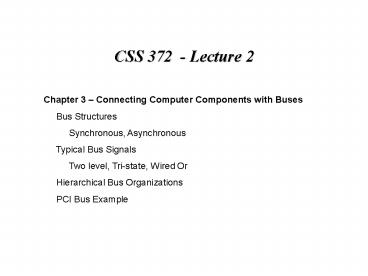CSS 372 - Lecture 2 - PowerPoint PPT Presentation
1 / 28
Title:
CSS 372 - Lecture 2
Description:
Synchronous, Asynchronous. Typical Bus Signals. Two level, Tri-state, Wired Or ... Asynchronous (Hand Shaking) Serial (Twisted pair, Coaxial Cable, ..) Parallel ... – PowerPoint PPT presentation
Number of Views:34
Avg rating:3.0/5.0
Title: CSS 372 - Lecture 2
1
CSS 372 - Lecture 2
Chapter 3 Connecting Computer Components with
Buses Bus Structures Synchronous,
Asynchronous Typical Bus Signals
Two level, Tri-state, Wired Or Hierarchical
Bus Organizations PCI Bus Example
2
What is a Bus?
- A communication pathway connecting two or more
devices (Computers, Components, I/O, ) - Usually broadcast
- Often grouped
- A number of channels in one bus
- e.g. 32 bit data bus is 32 separate single bit
channels - Power lines may not be shown
3
What do Buses look like?
- Parallel lines on circuit boards
- Ribbon cables
- Strip connectors on mother boards
- Sets of wires
4
Types of Buses
- Synchronous
- Asynchronous (Hand Shaking)
- Serial (Twisted pair, Coaxial Cable, ..)
- Parallel (Ribbon Cable,
5
Types of Buses
- Dedicated
- Separate data address lines
- Multiplexed
- Shared lines
- Address valid or data valid control line
- Advantage - fewer lines
- Disadvantages
- More complex control
- Ultimate performance
6
Physical Considerations for Buses
- Media (voltage, optic)
- Signal levels the higher, the more immune to
noise - Noise Absorption wires can pick up noise from
neighboring wires - Noise Generation wires can be antennas
- Length
- Creates Delay ( reduces Bandwidth)
- Consumes Power
- Creates reflections (Terminations
become more critical)
7
Logic Threshold Voltage Levels
8
Signal Scheme Alternatives
- Totempole - High or Low output level
- Line always at a 1 level or 0 level
- Open collector, open drain, wired-or
- Line is nominally at a 1 level or 0 level
line is pulled to non-nominal level - Tristate
- Has third state open
- Differential
- Uses a pair of lines the level is the
difference of signals on the two lines.
9
Bus Challenges
- Lots of devices on one bus leads to
- Propagation delays
- Long data paths mean that co-ordination of bus
use can adversely affect performance - Traffic congestion
- Too many devices communicating reduces bandwidth
- Alternative - Systems use multiple buses
10
Simple Computer Bus
clock(s), power(s), and
ground(S) Notes 1) Bus lines need to be
properly terminated 2) Power lines are
to furnish reference voltage, not power
11
Adding an Expansion Bus
12
Hierarchical Bus Structure
13
Bus Arbitration
- More than one module may need to control the bus
- e.g. CPUs and DMA controller
- Only one module may control the bus at one time
- Arbitration may be centralised or distributed
14
Centralised or Distributed Arbitration
- Centralised
- Single hardware device controlling bus access
- Bus Controller
- Arbiter
- May be part of CPU or separate
- Distributed
- More than one module may claim the bus
- Need control logic on all these modules
15
Timing
- Co-ordination of events on bus
- Synchronous
- Events determined by clock cycles
- Control Bus includes clock line(s)
- A single 1-0 is a bus cycle (or phase)
- All devices can read clock line
- Likely sync on leading edge
- Likely a single cycle for an event
- (may be multiple clock cycles or phases)
16
Timing Diagram Conventions
17
Synchronous Timing Diagram
18
Asynchronous Timing Read Diagram
19
Asynchronous Timing Write Diagram
20
Example - PCI Bus
- Peripheral Component Interconnection
- Intel released to public domain
- 32 or 64 bit
- 50 lines
21
Typical PCI Bus Usage
22
Multiple PCI Bus Configuration
23
(No Transcript)
24
(No Transcript)
25
PCI Commands
- Transaction between initiator (master) and target
- Master claims bus
- Determine type of transaction
- e.g. I/O read/write
- Address phase
- One or more data phases
26
PCI Read Timing Diagram
27
PCI Bus Arbiter
28
PCI Bus Arbitration Timing































